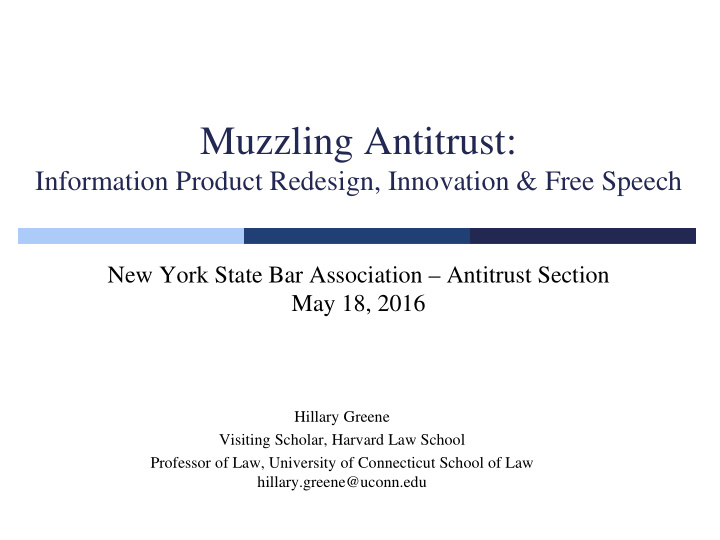



Muzzling Antitrust: Information Product Redesign, Innovation & Free Speech New York State Bar Association – Antitrust Section May 18, 2016 Hillary Greene Visiting Scholar, Harvard Law School Professor of Law, University of Connecticut School of Law hillary.greene@uconn.edu
Milo 2.0 H.Greene / NYSBA Antitrust / May 2016 2
Milo 1.0 H.Greene / NYSBA Antitrust / May 2016 3
Information products “[A]nything that can be digitized…. [B]aseball scores, books, databases, magazines, movies, music, stock quotes, and Web pages are all information goods.…” C ARL S HAPIRO & H AL R. V ARIAN , I NFORMATION R ULES : A S TRATEGIC G UIDE TO THE N ETWORK E CONOMY 3 (1999) H.Greene / NYSBA Antitrust / May 2016 4
Information products (re)design Google – rankings Approximately 70% of general search engine market Changes to search engine algorithm Search bias alleged (advantage Google and disadvantage vertical competitors) A.C. Nielsen – ratings Effectively 100% television ratings market Changes to people meter technology Predatory innovation alleged H.Greene / NYSBA Antitrust / May 2016 5
Treatment of speech and innovation-based defenses in antitrust matters? Δ “information product” speech ? “The First Amendment Protects Search Engine Results Against Antitrust Law” Eugene Volokh & Donald Falk (White Paper Commissioned by Google (April 2012)) “[Nielsen’s] are opinions that are protected by the First Amendment and, thus, cannot give rise to antitrust liability.” Sunbeam v. Nielsen, Defendant’s Motion to Dismiss & Memorandum (July 2009) Δ “information product” innovation ? “We make hundreds of changes to our algorithms every year to improve consumers’ search experience.” Eric Schmidt (Senate Testimony (Sept. 2011) “[Antitrust] is not supposed to be in the business of policing … the quality [of a monopolist’s] services.” Sunbeam v. Nielsen, Defendant’s Motion to Dismiss & Memorandum (July 2009) 6 H.Greene / NYSBA Antitrust / May 2016
All-or-nothing protection re. “speech” Binary approach – immunity or no solicitude U.S. v. Lorain Journal (U.S. 1951) E . R . R . Pres . Conf . v . Noerr Motor Freight (U.S. 1961) Insufficiency of binary approach NAACP v. Claiborne County Hardware (U.S. 1982) FTC v. Superior Court Trial Lawyers Assoc . (U.S. 1990) Alternatives to binary approach Central Hudson (intermediate scrutiny (“restriction proportional to interest”))(U.S. 1980) NYT v. Sullivan (conditional privilege (“actual malice”))(U.S. 1964) H.Greene / NYSBA Antitrust / May 2016 7
De facto all-or-nothing protection re. “innovation” De facto binary approach Explicitly eschews balancing – Allied Orthopedic v. Tyco Health (9 th Cir. 2010) Embraces balancing in theory – US v. Microsoft (D.C. Cir. 2001) Insufficiency of de facto binary approach Redesigns do not have concurrently pro & anticompetitive effects Very small innovations trump all anticompetitive effects Alternatives to binary approach Limited approach – first order and not “full blown” balancing H.Greene / NYSBA Antitrust / May 2016 8
Recommendations – Speech Political speech receives immunization Nominal speech receives no solicitude Additional legal infrastructure proposed cognizable speech (not a single “outcome category”) Definition: Significant speech content related to cause of action Mechanism: “Minus factor” provides sliding scale protection Presumption: Tie-breaker unless strong speech content H.Greene / NYSBA Antitrust / May 2016 9
Recommendations – Innovation Recognition and estimation of pro/anticompetitive effects Translation between dynamic and static effects Implementation of sliding scale and presumptions Balance when confident of large relative differences Retain default in favor of innovation “Size” of Innovation small unsure large “Size” of small no no no Anticompetitive unsure no no no Effect large yes no no H.Greene / NYSBA Antitrust / May 2016 10
Take away… Inappropriate abdication appropriately tailored assessments Limitations of existing case law learning by doing Middle ground alternatives to binary treatment More speech regarding these First Amendment considerations More innovation regarding dynamic efficiency considerations H.Greene / NYSBA Antitrust / May 2016 11
Thank you & further reading Hillary Greene, Muzzling Antitrust: Information Products, Innovation and Free Speech , 95 B OSTON U NIVERSITY L AW R EVIEW 35 (2015), available at , http://papers.ssrn.com/sol3/papers.cfm abstract_id=2577920 Hillary Greene, Weighing Google’s Antitrust Defenses , W ALL S TREET J OURNAL (Oct. 1, 2015), available at , http://on.wsj.com/1TOtNXM H.Greene / NYSBA Antitrust / May 2016 12
Recommend
More recommend